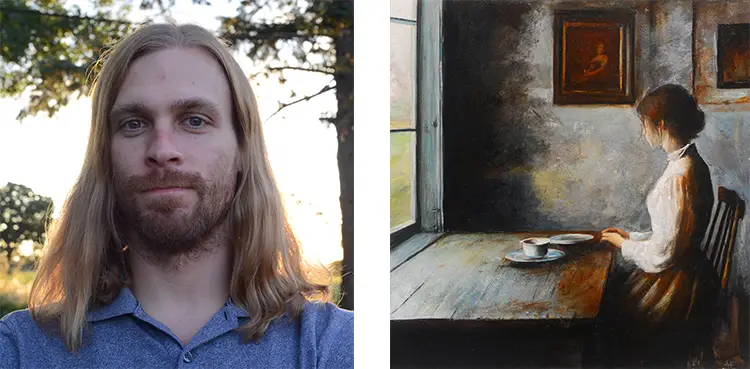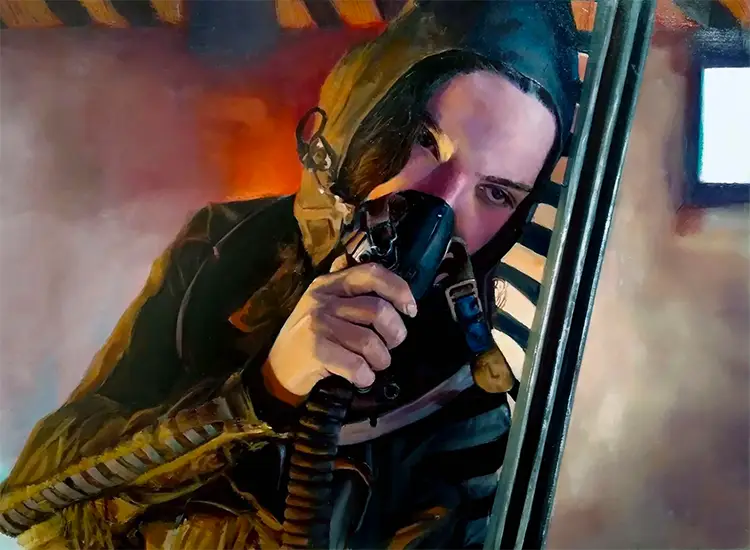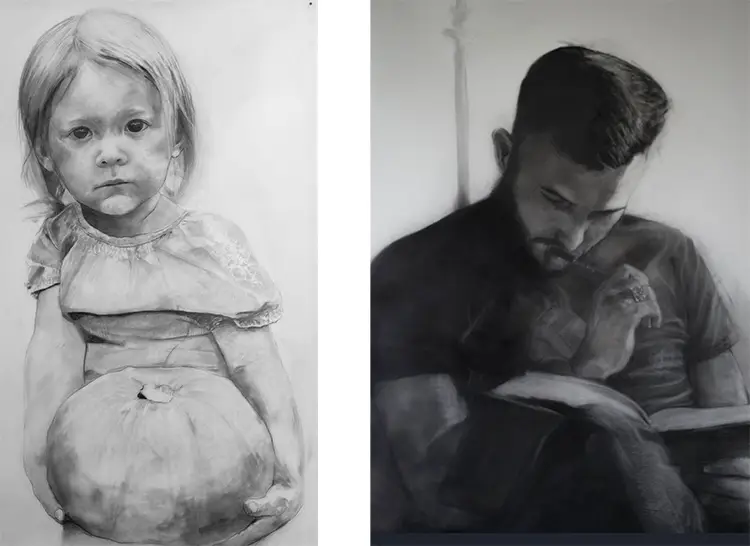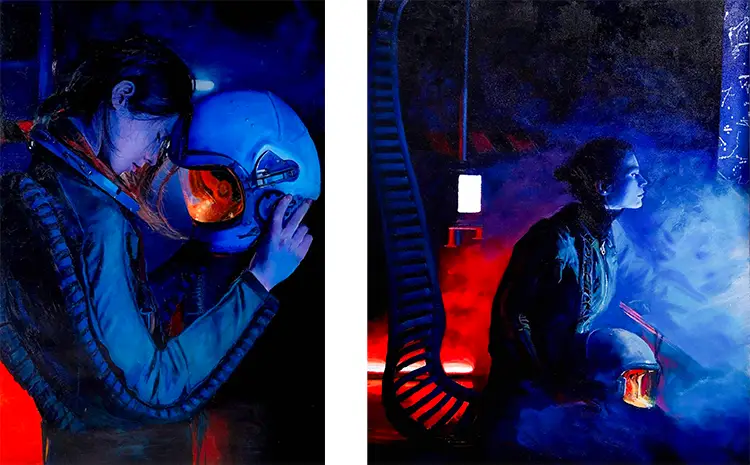“Each image is a quiet offering, a narrative fragment through which others might see their own longing reflected back.”
The Quiet Assertion of Form
The work of Andrew Elsten resists easy classification. As a visual artist, father, and educator, he channels his creative voice through a tension-laden stillness, where technical exactitude collides with emotionally complex terrain. His pieces are neither overtly expressive nor deliberately obscure; rather, they occupy a liminal space where restraint becomes revelation. Drawing on both a rural upbringing and a deep sensitivity to contradiction, Elsten’s visual output functions as a quietly defiant refusal to over-explain, choosing instead to leave space for others to project, interpret, and feel without being led. His practice lives not in the flourish of answers but in the architecture of thoughtful questions.
Raised in an environment where language bore the double weight of discipline and danger, Elsten discovered drawing not as a creative outlet but as a necessary redirection of inner energy. Words, while present, often carried uncertainty; images, by contrast, provided a mode of reconfiguration. From an early age, he understood that pictures could reroute meaning—divert, obscure, and preserve all at once. This nuanced approach became foundational to his aesthetic philosophy. In a home where stillness was both expected and unsafe, his hand learned to speak in gestures that could hold memory without spectacle, ambiguity without evasion.
Rendering, for Elsten, is not simply about capturing likeness; it is about establishing authorship. His use of drawing and painting is a meditative act of discernment—choosing what to unveil and what to obscure. The emphasis on physical labor, inherited from a childhood where manual work held more legitimacy than emotional articulation, infuses his studio practice with a tactile intentionality. Hands, once tools of survival, now sculpt presence into line and tone. It is in this physical devotion—carefully arranged tools, cherished ephemera, ritualistic quiet—that Elsten’s work begins its true inquiry: what does it mean to be seen, and what must remain unsaid?

Andrew Elsten: Between Presence and Omission
Elsten’s early artistic journey was not one of confident ambition but of urgent necessity. He did not enter art with ease or assurance but was drawn toward it by the paradox it offered: the impossible act of making beauty from nothing. Initially steered toward engineering, he found solace in drafting’s structure and clarity, yet was left unsatisfied by the sterility of digital design. What he craved—what ultimately pulled him into the art world—was the physicality of creation: graphite under fingernail, the resistance of surface beneath line, the silence of thought made visible through motion. It was the discomfort of not knowing, of struggling to translate emotion into form, that revealed itself as essential.
His decision to transition from engineering to art marked a turning point that would redefine his understanding of meaning and material. Art, for Elsten, was never merely a visual pursuit; it became a site of transformation, a place where quiet personal reckonings could be processed through mark-making. He recalls the pivotal moment of serving as a teaching assistant, where witnessing others navigate their creative vulnerabilities opened a new way of being. Teaching was not separate from his art practice—it was an extension of it. Here, artistic engagement became communal, a mode of healing rooted in mutual exploration and reflective presence.
A signature moment in Elsten’s creative development occurred with the piece Jasey Buys a Pumpkin, the inaugural work in his Melancholia series. Originating from a poem rather than an image, the drawing captures a subdued, poignant moment between a father and daughter in a pumpkin field. It is not nostalgia that drives the piece but a recognition of memory on the cusp of transformation—tenderness tinged with impending loss. This drawing became a watershed in his practice, demonstrating that art could operate as both artifact and emotional residue. Its significance deepened with the personal timing: it was the last child portrait he completed before becoming a father himself. In retrospect, Jasey holds a quiet foresight, becoming less about depiction and more about premonition, marking a shift toward intimacy through omission.

Architecture of Ambiguity
Elsten’s style is characterized by an intentional quietness that defies performative visual culture. He operates within a language of subtlety: tonal restraint, compositional balance, and an enduring allegiance to the emotional undercurrents that often go unspoken. Rather than seeking resolution, his works ask the viewer to linger in uncertainty. The recurring motifs—ritual, ambiguity, loss, and emotional opacity—do not scream for attention; they whisper, inviting deeper examination. Each figure, each environment, feels suspended in the act of becoming, never fully defined yet unmistakably present. His subjects possess a privacy that commands respect, not through concealment but through sovereignty.
Rather than crafting allegorical narratives, Elsten explores atmospheric suggestion. His figures are less characters than conduits—vessels of gesture, mood, and memory. In his visual world, grief does not wail; it lingers. Beauty does not assert itself; it reveals slowly. The silence embedded in his compositions is deliberate, a space for viewers to experience recognition without instruction. He is not interested in spectacle or resolution, but in presence—how it can be depicted without surrendering its integrity. The emotional clarity in his work comes not from what is said, but from what is carefully left untouched.
Materials are as central to Elsten’s process as concept. His favored media—oil, charcoal, and graphite—offer a spectrum between discipline and surrender. Each tool allows him to toggle between control and spontaneity, between form and collapse. Mylar, a surface he frequently employs, underscores this dynamic. Its resistance to absorption forces every mark to remain visible, preserving the decision-making process as part of the final image. The surface resists erasure, mirroring the emotional complexity he seeks to express: nothing is entirely forgotten, everything remains imprinted. Even when he sands or scrapes, the trace of intention lingers. His materials become metaphors, mirroring the human need to withhold, reveal, and navigate interior truths without spectacle.

Andrew Elsten: Against the Gravity of Irony
Elsten’s current projects demonstrate a deepening commitment to emotional clarity and conceptual rigor. One of these ventures, a speculative novel set in a galaxy succumbing to a phenomenon called the Withering, approaches themes of memory erosion, existential drift, and interior collapse. The story is less interested in catastrophe than in its quieter counterpart: the slow disintegration of meaning. Told through multiple perspectives—a child, an archivist, a scientist—the narrative explores how identity fractures when traditional frameworks dissolve. What remains when language falters, when memory fades, when purpose erodes? Elsten approaches writing as he does visual art: in layers, with restraint, and a reverence for what cannot be fully articulated.
Alongside this literary project, Elsten is developing a series of paintings rooted in American regionalist aesthetics, but stripped of nostalgia. These works draw on seasonal gestures, transitional moments, and the minor rituals of ordinary life—figures waiting, departing, reflecting. By fusing ephemeral figuration with a palette reminiscent of regionalist traditions, he challenges the irony-saturated modes of contemporary visual culture. Rather than mocking sincerity, these paintings lean into it. They operate as aesthetic counterweights, resisting the emotional detachment that often defines trend-driven art. Each brushstroke becomes a quiet act of defiance, reclaiming beauty and stillness as valid, even urgent, artistic modes.
Central to both projects is a shared philosophical stance: a refusal to simplify. Elsten pushes against the prevailing tides of spectacle, irony, and performative detachment. In a cultural moment preoccupied with immediacy and surface, his work insists on depth, ambiguity, and ethical authorship. He doesn’t aim to provoke with shock or dazzle with flair; instead, he invites contemplation, asking audiences to sit with discomfort, to seek meaning in the subtleties. His work—whether on canvas or the page—asks: What does it mean to create art that holds emotional and ethical gravity? How can we honor interiority without exploiting it? In his ongoing pursuit of these questions, Elsten continues to shape a practice defined not by answers, but by the richness of asking.








